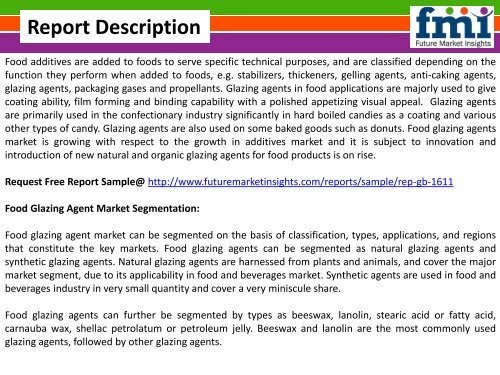Food Glazing Agent Market Analysis, Segments, Growth and Value Chain 2016-2026
Food additives are added to foods to serve specific technical purposes, and are classified depending on the function they perform when added to foods, e.g. stabilizers, thickeners, gelling agents, anti-caking agents, glazing agents, packaging gases and propellants. Glazing agents in food applications are majorly used to give coating ability, film forming and binding capability with a polished appetizing visual appeal. Glazing agents are primarily used in the confectionary industry significantly in hard boiled candies as a coating and various other types of candy. Glazing agents are also used on some baked goods such as donuts. Food glazing agents market is growing with respect to the growth in additives market and it is subject to innovation and introduction of new natural and organic glazing agents for food products is on rise.
Food additives are added to foods to serve specific technical purposes, and are classified depending on the function they perform when added to foods, e.g. stabilizers, thickeners, gelling agents, anti-caking agents, glazing agents, packaging gases and propellants. Glazing agents in food applications are majorly used to give coating ability, film forming and binding capability with a polished appetizing visual appeal. Glazing agents are primarily used in the confectionary industry significantly in hard boiled candies as a coating and various other types of candy. Glazing agents are also used on some baked goods such as donuts. Food glazing agents market is growing with respect to the growth in additives market and it is subject to innovation and introduction of new natural and organic glazing agents for food products is on rise.
You also want an ePaper? Increase the reach of your titles
YUMPU automatically turns print PDFs into web optimized ePapers that Google loves.
Report Description<br />
<strong>Food</strong> additives are added to foods to serve specific technical purposes, <strong>and</strong> are classified depending on the<br />
function they perform when added to foods, e.g. stabilizers, thickeners, gelling agents, anti-caking agents,<br />
glazing agents, packaging gases <strong>and</strong> propellants. <strong>Glazing</strong> agents in food applications are majorly used to give<br />
coating ability, film forming <strong>and</strong> binding capability with a polished appetizing visual appeal. <strong>Glazing</strong> agents<br />
are primarily used in the confectionary industry significantly in hard boiled c<strong>and</strong>ies as a coating <strong>and</strong> various<br />
other types of c<strong>and</strong>y. <strong>Glazing</strong> agents are also used on some baked goods such as donuts. <strong>Food</strong> glazing agents<br />
market is growing with respect to the growth in additives market <strong>and</strong> it is subject to innovation <strong>and</strong><br />
introduction of new natural <strong>and</strong> organic glazing agents for food products is on rise.<br />
Request Free Report Sample@ http://www.futuremarketinsights.com/reports/sample/rep-gb-1611<br />
<strong>Food</strong> <strong>Glazing</strong> <strong>Agent</strong> <strong>Market</strong> Segmentation:<br />
<strong>Food</strong> glazing agent market can be segmented on the basis of classification, types, applications, <strong>and</strong> regions<br />
that constitute the key markets. <strong>Food</strong> glazing agents can be segmented as natural glazing agents <strong>and</strong><br />
synthetic glazing agents. Natural glazing agents are harnessed from plants <strong>and</strong> animals, <strong>and</strong> cover the major<br />
market segment, due to its applicability in food <strong>and</strong> beverages market. Synthetic agents are used in food <strong>and</strong><br />
beverages industry in very small quantity <strong>and</strong> cover a very miniscule share.<br />
<strong>Food</strong> glazing agents can further be segmented by types as beeswax, lanolin, stearic acid or fatty acid,<br />
carnauba wax, shellac petrolatum or petroleum jelly. Beeswax <strong>and</strong> lanolin are the most commonly used<br />
glazing agents, followed by other glazing agents.

















